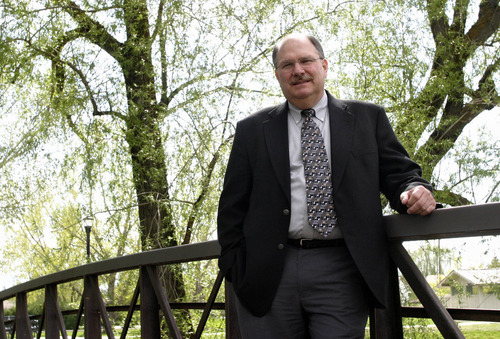This is an archived article that was published on sltrib.com in 2012, and information in the article may be outdated. It is provided only for personal research purposes and may not be reprinted.
Cleaning out his desk in preparation for retirement, Division of Wildlife Resources director Jim Karpowitz came across the first story written about his wildlife career.
The yellowed copy of the March 29, 1979, Salt Lake Tribune featured a photo of Karpowitz and a bobcat that was part of a Brigham Young University study.
Reminiscing about a 34-year DWR career that began on duck marshes in 1976 and took him to nearly every wild place in Utah, Karpowitz thought that the bobcat named Bob, featured in a story that I wrote, might have proved to be his undoing as a wildlife biologist.
Bob was kept in a small house on the edge of the BYU campus. Karpowitz, a student at the school, went into the building one day and, thinking the full-grown animal was in its cage, threw open a window. But someone had let Bob out and the smart cat quickly leapt out of the window.
He chased the animal around campus for 30 minutes but could not catch him. Another student, who had worked with the cat and befriended him, walked toward Bob and called his name. The cat playfully jumped into her arms.
Having survived that "career scare," Karpowitz would go on to pioneer bighorn sheep transplant techniques and, in May 2005, was named the director of the DWR.
Since he is the ninth head of the agency I have covered since the 1970s, I know how difficult this job can be. Karpowitz said that of the previous 10 directors, six were either fired or resigned, three died in office and only one retired.
"I hope I am the second [to retire]," he grinned, about 30 days out from his retirement.
The job can be difficult because politicians, members of the wildlife board and the public are quick to pounce when things aren't going well in a highly political job. The agency supports Utah's $2.3 billion wildlife industry. But there are groups with vastly different agendas that must be appeased.
Within the hunting community, you have those who hunt for meat, some seeking trophies, family groups, waterfowl and upland enthusiasts, archers, muzzleloaders and conservation organizations with missions that sometimes conflict.
Some anglers want to seek planted fish on flatwater. Others hope to catch wild trout on mountain streams. Some want to fish close to home while some groups prefer warm-water angling.
Then there are the nonconsumptive wildlife watchers, who bring a whole different set of needs and wishes into the wildlife game. Many in this category dislike programs that kill native predators to increase big-game populations. They would like to see wolves back in Utah and feel the agency ignores their needs.
Finally, unlike most government agencies, the DWR relies primarily on the sale of hunting and fishing licenses coupled with federal excise taxes on arms and fishing gear to fund the majority of its programs. So it must keep its "customers" happy to survive.
Karpowitz's term as director was successful in many ways.
First, he worked to restore 1 million acres of watershed in Utah, something that benefits all types of wildlife. He oversaw battles against invasive species such as phragmites on Utah marshes or cheat grass on ranges. The number of community fisheries increased from 19 to 50 during his term as director.
Revenue increased as 90,000 more anglers bought licenses than when he started as director. Last year, the agency received 330,000 big-game applications. The money situation has improved to the point where the DWR will almost certainly not seek a license increase this year. A new wildlife recreation program rolled out recently is designed to get people to try outdoor activities, and that could yield fruits.
This isn't to say that everything has been perfect.
Karpowitz, who resides in Riverton, admits frustration that deer herds have not recovered as quickly as he would have liked. A reduction in deer hunting permits and change to a 30-unit draw system created confusion and criticism. There have been debates over wolves, cougars and coyotes.
But there has been much more good than bad for this low-key guy who always made an effort to listen to anyone.
"It's been a fun and interesting career," said Karpowitz, who may work part time for a conservation group in the future. "There have been lots of changes and lots of challenges. But I am leaving things in good hands. We have a lot of good employees."
Twitter @tribtomwharton



